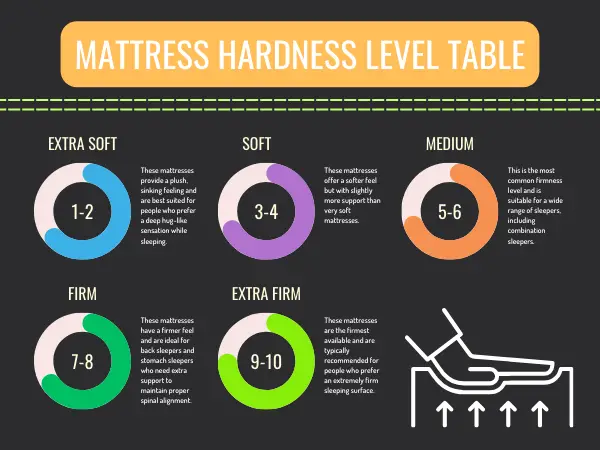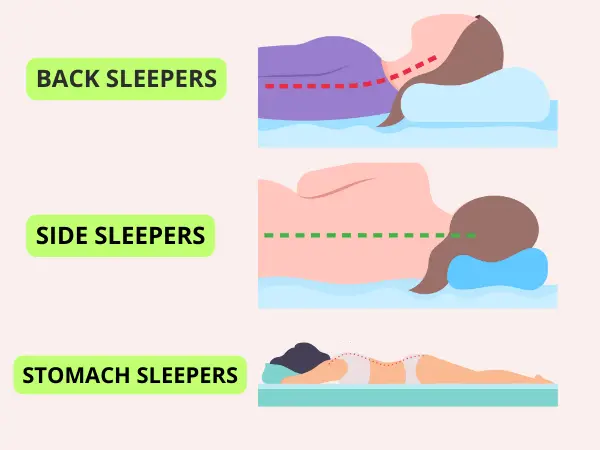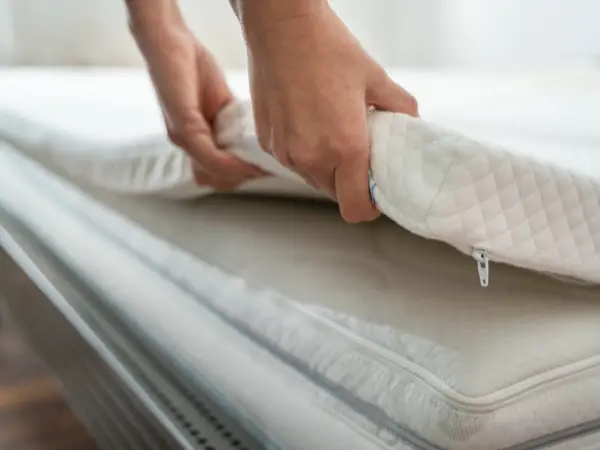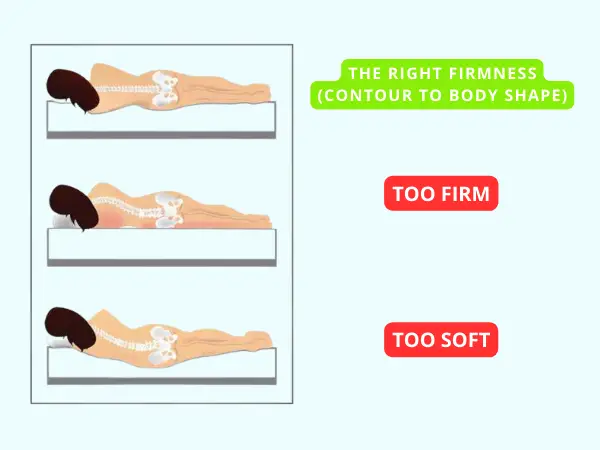Choosing the right mattress firmness enhances sleep quality and comfort. Consider your sleep position and body weight for optimal support.
Selecting a mattress of proper firmness is essential for a good night’s sleep, impacting both comfort and health. Your choice should align with personal sleeping habits, health requirements, and preference for mattress feel. For side sleepers, a softer mattress can cushion the shoulders and hips, while back and stomach sleepers may benefit from firmer support to align the spine.
Weight also plays a crucial role; heavier individuals might lean towards a firmer option to prevent excessive sinking, and lighter persons could opt for a softer surface for adequate pressure relief. A well-chosen mattress firmness can alleviate pain, improve posture, and contribute to a restorative sleep experience.
Key Factors To Consider When Selecting Mattress Firmness
Choosing the right mattress firmness is crucial for a comfortable sleep. Consider body weight, sleeping position, mattress type, and personal preference. Each plays a vital role in determining the perfect firmness for your body. Let’s delve deeper into these key factors.
Body Weight
Body weight significantly influences mattress firmness. Use this guide:
- Lighter sleepers (<130 lbs): Softer mattresses can provide adequate support.
- Average sleepers (130-230 lbs): Aim for medium firmness for a balance of support and comfort.
- Heavier sleepers (>230 lbs): Firmer mattresses help prevent sinkage and maintain spinal alignment.
Type Of Mattress
The type of mattress affects firmness perception. Common types:
- Innerspring: Usually firmer, great for support.
- Memory Foam: Contours to the body, ranges from soft to firm.
- Latex: Often firmer, responsive feel.
- Hybrid: Combines foam and springs, offers varying firmness levels.
Personal Preference
Personal preference should guide your final choice. Trust your comfort level. Test different firmness options. Combine your preferences with the above factors for the best result.

Understanding Mattress Firmness Levels
Selecting the right mattress firmness is crucial for a good night’s sleep. Firmness affects comfort, support, and overall sleep quality. Understanding the scale from extra soft to extra firm helps you match your sleeping style to the perfect mattress.
Extra Soft (1-2)
Extra soft mattresses provide a cloud-like feeling. Ideal for lighter individuals, these mattresses allow you to sink in deeply, contouring your body closely. Side sleepers often benefit from the plushness, soothing pressure points.
Soft (3-4)
Soft mattresses still offer significant give but with more support than extra soft options. They work well for side sleepers who prefer a bit more structure and those of a lighter weight seeking gentle contouring.
Medium (5-6)
Medium firmness strikes a balance, providing even support for various sleeping positions. It’s a versatile choice, catering to the widest range of sleepers, including couples with different comfort preferences.
Firm (7-8)
Firm mattresses offer more support, limiting sinkage. Ideal for back and stomach sleepers, they keep the spine aligned. Heavier individuals might also prefer this level as it prevents feeling stuck in bed.
Extra Firm (9-10)
Extra firm mattresses are the most supportive with minimal cushioning. Sleepers not requiring deep conforming, or those who need stable support for their back, often go for this firmness level.

Matching Firmness Levels To Sleeping Positions
Choosing the right mattress firmness contributes to a good night’s sleep. Different sleeping positions require varying levels of support. This guide helps match firmness levels to every sleeping style.
Side Sleepers
Soft to medium firmness is ideal for side sleepers. This provides cushion for the shoulders and hips. It ensures proper spine alignment. A too firm mattress can cause pressure points and pain.
Back Sleepers
Back sleepers benefit from medium to firm mattresses. These support the natural curve of the spine. A firm base with a soft top layer can offer comfort and stability.
Stomach Sleepers
Stomach sleepers need a firm mattress. It prevents the body from sinking too much. This keeps the spine in a neutral position and avoids back pain.
Combination Sleepers
Combination sleepers should go for medium firmness. A responsive mattress adapts to various positions. It balances comfort and support for a restful sleep.

Effects Of Firmness On Body Support And Alignment
Understanding the impact of mattress firmness is key to promoting restful sleep and ensuring overall health. The right level of firmness provides essential body support and maintains proper spine alignment during sleep. This guide delves into how different firmness levels affect body support and alignment.
Spinal Alignment
Choosing a mattress that supports correct spinal alignment is fundamental. A mattress that is too firm can push against the spine. One that is too soft may cause the body to sink. Either extreme can lead to discomfort or pain.
- Soft Mattress: May allow hips and shoulders to sink too deeply, misaligning the spine.
- Medium Firmness: Provides balanced support, cradling the body while keeping the spine straight.
- Firm Mattress: Best for individuals who sleep on their back or stomach, helping keep the spine in a neutral position.
Pressure Points
Pressure points affect sleep quality significantly. The ideal mattress firmness relieves pressure on the hips, shoulders, and lower back.
- Side sleepers often prefer medium-soft to medium-firm mattresses to cushion their pressure points.
- Back sleepers benefit from medium to firm mattresses, which alleviate pressure without causing the back to arch.
- Stomach sleepers require firm mattresses to prevent the abdomen from sinking and straining the back.
Body Contouring
Mattress firmness affects how well it can contour to the body’s natural shape. An appropriately contoured mattress can uniformly distribute weight and reduce stress on the body’s key areas. This benefit is about balance; not too rigid, not too plush.
| Mattress Type | Contouring Level | Recommended For |
|---|---|---|
| Memory Foam | High | Side Sleepers |
| Latex | Medium | Combination Sleepers |
| Innerspring | Low | Back and Stomach Sleepers |
What Is The Best Firmness For A Mattress?
Finding the perfect mattress firmness can transform your sleep experience. The right firmness level supports your body, keeps your spine in alignment, and promotes rejuvenating sleep. But how can you tell which firmness is best for you? It’s not just about soft or hard; it’s about finding the sweet spot that your body needs.
Finding Your Ideal Firmness
Personal preference plays a big role in choosing mattress firmness. However, your sleep position, weight, and health issues also influence the decision.
- Side sleepers may prefer softer mattresses to cushion shoulders and hips.
- Back sleepers often need a medium firmness for optimal spine alignment.
- Stomach sleepers tend to benefit from firmer mattresses, reducing lower back strain.
- Heavier individuals may find a firmer mattress provides better support.
- People with back pain might need a medium-firm mattress for comfort and support.
Adjusting Firmness Levels
Your mattress’s firmness can change over time, or you might need to adjust it for comfort. Here’s how:
- Add a mattress topper for increased softness or support.
- Consider a modular bed where individual sections can be adjusted.
- Look into adjustable airbeds that allow you to modify firmness electronically.
In conclusion, personal needs and preferences should guide your choice, but you can always modify firmness to suit changes in your comfort requirements.

Is Firmness The Same As Support?
Choosing the right mattress can transform sleep from a nightly challenge into a nightly bliss. A common question arises: Is firmness the same as support? While they seem similar, they are not identical. Understand the difference to help find the perfect sleep oasis.
Understanding Firmness Vs. Support
Firmness refers to the initial feel of a mattress when you lie down. Think of it like the first handshake with a mattress. It can be soft, medium, or firm. Support, however, is the way a mattress keeps your spine aligned. A good mattress must offer the right support, regardless of its firmness level.
- Firmness is the comfort level felt on the mattress surface.
- Support involves keeping the spine in alignment during sleep.
Balancing Firmness And Support
Finding a balance between firmness and support is crucial. A mattress too firm may push against the spine. Too soft, and it might not support the midsection, causing back pain. Aim for a mattress that feels comfortable but also keeps your back straight.
| Firmness Level | Best for | Support Quality |
|---|---|---|
| Soft | Side sleepers | Varies |
| Medium | Most sleepers | Good |
| Firm | Stomach and back sleepers | Excellent |
Select a mattress that provides both. Look at your sleep habits, body type, and comfort preferences. Keep your spine aligned while not sacrificing comfort. Test different mattresses to find your ideal firmness and support balance.

How To Choose Your Mattress Firmness
Choosing the right mattress firmness isn’t just about comfort— it affects sleep quality and health too. Your perfect mattress should support your body while relieving pressure points. Let’s dive into a step-by-step guide on pinpointing your ideal mattress firmness.
Step-by-step Firmness Selection
- Consider your weight: Body weight influences how a mattress feels. Heavier individuals may require firmer options.
- Analyze your sleep position: Side sleepers often benefit from softer mattresses, while back and stomach sleepers may prefer firmer surfaces.
- Reflect on your current mattress: Think about your current bed — is it too soft or too firm?
- Identify any pain issues: If you experience back pain, a medium-firm mattress might offer better support.
- Conduct a comfort test: If possible, test mattresses in-store or consider companies that offer trial periods.
Tips For Deciding Your Ideal Firmness
- Start with medium firmness: Medium firmness suits various body types and sleep positions and thus can be a safe starting point.
- Access individual needs: Consider personal comfort, partner preferences, and sleep habits.
- Read reviews: Customer feedback provides insight into how mattresses feel in real-life settings.
- Check warranties: A good warranty can offer assurance when trying out a new firmness level.
Common Misconceptions
Choosing the right mattress firmness can feel tricky. Many myths float around about what firmness means for sleep quality. Let’s debunk some common misconceptions and pave the way towards restful nights.
Firmness Equals Support
A popular belief is that firmness and support are the same. They are not. Firmness refers to the feel of the mattress when you lie down. Support speaks to how well a mattress keeps your spine aligned. You can have excellent support with both soft and firm beds. The key is ensuring proper spinal alignment, regardless of firmness level.
Firm Mattresses Are Always Better
Another myth is that firmer mattresses are universally superior. In truth, perfect firmness is subjective. It depends largely on sleep position and personal comfort preference. Side sleepers may prefer a softer mattress to cushion shoulders and hips. Back and stomach sleepers might lean towards a firmer surface. Person’s weight and health condition also play roles in determining the ideal firmness.
Soft Mattresses Are Not Supportive
The idea that soft mattresses fall short on support is false. A quality soft mattress can offer as much support as a firm one. Good support is tied to the mattress’s core. The core must hold up the body without sagging. Look for a soft mattress with a durable, supportive foundation. This ensures your body gets the support it needs.
Frequently Asked Questions
What Level Of Firmness Should My Mattress Be?
The ideal mattress firmness depends on your sleep position and personal comfort preference. Side sleepers often benefit from medium-soft to medium-firm, while back and stomach sleepers may prefer medium-firm to firm mattresses to support proper spinal alignment.
How Do I Pick Mattress Firmness?
To pick mattress firmness, consider your sleep position, weight, and comfort preferences. Side sleepers typically prefer a softer mattress, while back and stomach sleepers may benefit from firmer support. Test different firmness levels to determine what feels best for your body.
What Firmness Should Side Sleepers Use?
Side sleepers typically benefit from medium-soft to medium-firm mattresses. This range offers a blend of support and cushioning for shoulder and hip comfort.
What Firmness Are Hotel Mattresses?
Hotel mattresses typically range from medium to medium-firm to accommodate the preferences of a wide array of guests and ensure a comfortable sleep experience.
Conclusion
Selecting the perfect mattress firmness isn’t just about comfort; it’s key to your overall sleep health. Remember the Goldilocks principle and aim for that ‘just right’ feel. Don’t forget to weigh personal preference alongside sleep positions and body type. Sweet dreams start with the right support—choose wisely and rest easy!



